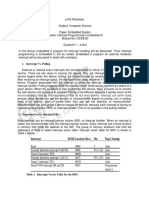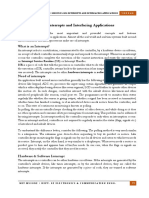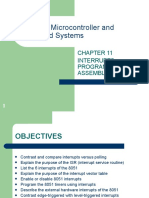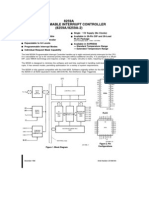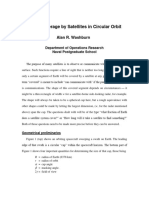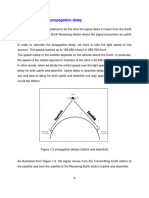0 ratings0% found this document useful (0 votes) 220 views1 pageExplain Polling and Interrupts
Copyright
© © All Rights Reserved
We take content rights seriously. If you suspect this is your content,
claim it here.
Available Formats
Download as PDF or read online on Scribd
i
errupt and interrupt pro-
concept of the interrupt anc pt p
1 Saal See oF OSI interrupts are discussed. In Section
: ers 0 and | are discussed. External hardware
11.3, while the interrupt related to serial com-
‘4, In Section 11.5, we cover interrupt prior
gramming. In Section 1
11.2 imerrupts belonging to Tin
inrrpts are discussed in Seton 1
‘munication is presented in Section Se cover inert pris
ity ae OSUS2. Finally, C programming of 8051 interrupts is covered in
Section 11.6.
SECTION 11.1: 8051 INTERRUPTS
In this section, first we examine the difference between polling and inter-
rupts and then describe the various interrupts of the 8051
Interrupts vs. polling
A single microcontroller can serve several devices. There are two ways to
do that: interrupts or polling. In the inferrupt method, whenever any device needs
its service, the device notifies the microcontroller by sending it an interrupt signal
Upon receiving an interrupt signal, the microcontroller interrupts whatever it is
doing and serves the device. The program associated with the interrupt is called
the interrupt service routine (ISR) ot interrupt handler, In polling, the microcon-
troller continuously monitors the status of a given device; when the status condi-
tion is met, it performs the service. After that, it moves on to monitor the next
device until cach one is serviced, Although polling can monitor the status of se
eral devices and serve each of them as certain conditions are met, it is not an effi-
cient use of the microcontroller. The advantage of interrupts is that the microcon-
troller can serve many devices (not all at the same time, of course); each device
can get the attention of the microcontroller based on the priority assigned to it
The polling method cannot assign priority since it checks all devices in a round-
Tobin fashion. More importantly, in the interrupt method the microcontroller can
also ignore (mask) a device request for service. This is again not possible with the
polling method. The most important reason that the interrupt method is preferable
's thatthe polling method wastes much of the microcontroller's time by polling
wad cere ae ae So in order to avoid tying down the microcon-
the isucon sang te For example indicussng timers in Chapter 9 we used
Mac ecyer iui. ze St » and waited until the timer rolled over, and
controllers time ier aia te ‘not do anything else, That is a waste of the micro-
cas ofthe times inc ans bee use fo perform some useful tasks. Inthe
a © interrupt method, the microcontroller can go about
oing other tasks, and when the TF
a lag is raised the timer will interna nicro-
Contoller in whatever itis doing,” sp hlpbepeaeetanlee
Interrupt service routine








